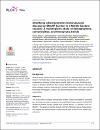Stratifying atherosclerotic cardiovascular disease by SMuRF burden in a Middle-Eastern country: A multiregistry study of demographics, comorbidities, and therapeutic trends.

View/
Date
2025Author
Alkouri, OsamaAlbikawi, Zainab
Saifan, Ahmad Rajeh
Khatatbeh, Haitham
Ababneh, Anas
Alobaidly, Alanoud
Qaladi, Omar
Alharbi, Abdulhafith
Hasan, Abdullah
Jarrah, Mohamad
Abuadas, Mohammad
Hammoudeh, Ayman
Alotaibi, Nader
AbuRuz, Mohannad E
Alhalaiqa, Fadwa
Al-Nsair, Nezam
...show more authors ...show less authors
Metadata
Show full item recordAbstract
Atherosclerotic cardiovascular disease (ASCVD) is a growing public health challenge in the Middle East, driven by increasing rates of obesity, diabetes, and hypertension. However, limited region-specific data exist on the distribution and impact of Standard Modifiable Risk Factors (SMuRFs) among affected individuals. Most available evidence is derived from Western populations, which may not reflect the unique demographic, cultural, and epidemiological profiles of Middle Eastern communities. This study aims to compare demographic profiles, clinical presentations, comorbidities, and pharmacologic management among Middle Eastern patients with ASCVD, stratified by SMuRF burden: SMuRF-less (no risk factors), 1-2 SMuRFs, and 3-4 SMuRFs. The goal is to identify clinically relevant differences across these groups and address the significant gap in region-specific data on ASCVD risk factors and outcomes. Data were pooled from six established cardiovascular registries and the Jordan SMuRF-less patient study. Baseline characteristics, cardiovascular risk profiles, comorbidities, use of secondary prevention therapies, and one-year outcomes were analyzed across the three SMuRF categories. Among 5,540 patients, the group with 3-4 SMuRFs exhibited the highest prevalence of hypertension (88.9%), diabetes (35.4%), smoking (54.0%), and a family history of cardiovascular disease (39.3%). This group also showed increased rates of chronic kidney disease (7.3%) and heart failure (15.1%). Statin, aspirin, and beta-blocker use increased in parallel with SMuRF burden. Key lipid profiles deteriorated with increasing SMuRFs, with the highest LDL cholesterol observed in patients with 1-2 SMuRFs. This study provides valuable insight into the clinical characteristics and management patterns of Middle Eastern patients with atherosclerotic cardiovascular disease (ASCVD), stratified according to the burden of standard modifiable risk factors (SMuRFs). An increased SMuRF burden was associated with a higher prevalence of comorbid conditions, including hypertension, diabetes mellitus, dyslipidemia, chronic kidney disease, and heart failure. Utilizing data from six regional registries, this study represents the first comprehensive, region-specific analysis of the role of modifiable risk factors in this population. The findings underscore the critical need for individualized, risk-based prevention and management strategies to mitigate the rising burden of ASCVD across the Middle East.
Collections
- Nursing Research [108 items ]

